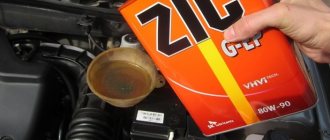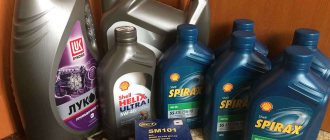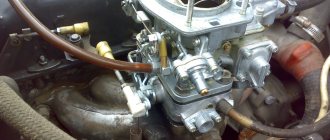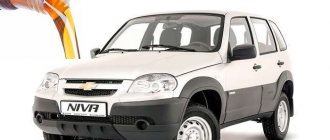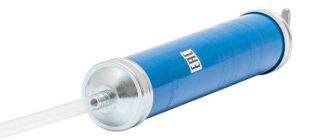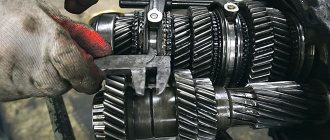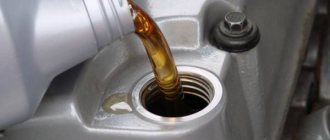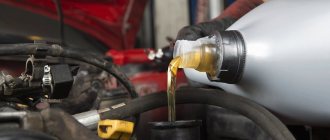Like many other loaded units and components in a car, the gearbox also needs lubrication. At the same time, special groups of transmission oils are used for gearboxes (depending on the type of gearbox).
As for the manual transmission, even taking into account the reliability and simplicity compared to analogues (automatic, variator, robotic gearbox), the manual transmission needs the correct selection of oil.
How to choose gear oil
When selecting transmission fluid, we recommend taking into account the specific loads acting in the mechanism and the relative sliding speed. The compositions differ in the degree of viscosity and the amount of compound. The sulfur compounds of extreme pressure additives cause chemical changes in the metal, but at the same time protect parts from wear. GL-4 is suitable for gearboxes of front-wheel drive cars, GL-5 - for other domestic cars. In stores you can find universal liquid GL-4/5.
Using the same oil for boxes of different brands can lead to breakdowns.
Many drivers fill in demi-season fluid. If you want to buy seasonal lubricant, choose it strictly for your gearbox and do not forget about the temperature. The viscosity index can be found in the automobile reference book.
Additives
We will separately consider a set of modern additives that allow transmission oils for gearboxes to better cope with their tasks and obtain the necessary performance characteristics.
- Anti-wear
. They function until there is enough oil in the gap between the gears of the gearbox. - Anti-seize.
Particularly useful at high loads, when the degree of friction approaches dry. - Anti-corrosion.
As the name suggests, they provide the gearbox with long-term corrosion protection. - Anti-friction.
They reduce friction and thereby save on fuel. - Antifoam
. Directly affect the quality of lubrication: a large amount of foam leads to a deterioration in the distribution of lubricant throughout the box.
What kind of oil should I put in a manual transmission?
To select a lubricant for a manual transmission (MTF), you must follow the manufacturer’s instructions, and also pay attention to two parameters - SAE fluid viscosity and API class, which is marked with the letters “GL”. At the moment, this marking is outdated, but let’s briefly consider this classification.
1. When choosing a viscosity, it is worth starting from the vehicle’s operating manual and taking into account the conditions in which the vehicle is used. This is due to the fact that thick liquids liquefy more slowly in cold weather and, accordingly, protect parts less well, and in warmer regions, viscous lubricants should be chosen, on the contrary, since when warmed up they become even more fluid. Transmission oils with SAE 75W90 and 80W90 are considered universal.
2. When choosing the GL classification, you need to take into account the year of manufacture of the car, the type of manual transmission and operating conditions.
- GL 1 is a universal class for transmission oils poured into mechanics. Used in spiral cone and worm type box. Not used in modern cars.
- GL 2 – used in agricultural and freight transport and has more antioxidant and anti-foam additives. Suitable for use in worm gears. . Not used in modern cars.
- GL 3 – Also suitable for use in medium-duty conditions for trucks with bevel gears. Increased extreme pressure additives. Rarely seen (obsolete), replaced by GL 4.
- GL 4 - transmission oils of this class are most often used in synchronized manual transmissions. Contains extreme pressure and anti-wear additives.
- GL 5 – suitable for use under high loads. Protects against wear and scuffing, ensures stable operation of synchronizers, due to a balanced additive package and a low sulfur percentage.
Oil changes in manual transmissions are carried out every 40-60 thousand kilometers.
Purpose of gearbox lubrication
The gearbox is the largest gearbox in a car transmission. Thanks to a stepwise change in the gear ratio, the driver has the opportunity to combine two ranges - wheel speed in the range of 50 - 1500 min-1 and engine crankshaft speed 800 - 8000 min-1. Depending on the type of transmission, the gears of the gearbox are lubricated in the following ways:
- cylindrical - oil bath with immersion of low-speed wheels to a third of the diameter, high-speed wheels to a depth of h = 5m;
- bevel - crankcase lubrication with the entire lower tooth of the gear immersed in oil;
- planetary - the high-speed stage is immersed in an oil bath to the entire depth of the inner tooth.
Spur gear box
Planetary gearbox
The drain hole must have a diameter greater than 20 mm, and the slope of the crankcase bottom must be within 3 degrees. The filler plug is usually located at the level of the oil bath mirror, which makes it possible to do without a dipstick.
Manual transmission drain hole
Information about what kind of oil to pour into a manual gearbox is relevant when repairing components and assemblies associated with the gearbox (for example, replacing the clutch) when the life of the lubricant itself is exhausted.
Transmission filler hole
The gearbox traditionally belongs to units with high operating loads. In addition, passenger car manufacturers use different gear designs in different car models, so the frequency of oil changes in manual transmissions is required in the manual.
The user should note that changing the oil in a manual transmission has nuances:
- with a minimum maintenance budget (filling with mineral oil), operating costs will increase as the lubricant life will decrease;
- when purchasing expensive synthetics, on the contrary, the initial investment will increase, but the service life of such oil is longer and the replacement frequency is greater than in the previous case;
- Semi-synthetics have a rational ratio of lubricant quality and cost.
Mineral oil
Synthetic oil
Semi-synthetic oil
There are winter, all-season and summer oils that allow you to select a lubricant for different operating conditions.
Thus, oil in a manual transmission solves several problems simultaneously:
- lubrication and reduction of friction of gears;
- heat removal from friction pairs;
- removal of metal filings from the surfaces of wear parts of the gearbox;
- protection of gears and gears from oxidation and corrosion.
The cost of 3 liters of gear lubricant is significantly lower than replacing a manual transmission or breaking a gear while driving.
For automatic transmission
In automatic transmissions, the loads are distributed slightly differently compared to previous types of transmissions, so the lubrication for them must be different. In this case, the canister will have the corresponding marking - ATF (the most common for most automatic machines).
In fact, these liquids have similar characteristics as the previous ones - extreme pressure, anti-corrosion, cooling. But for the lubrication of automatic machines, the requirements for viscosity-temperature characteristics are more stringent.
There are different types of automatic transmissions, and for each of them, manufacturers strictly regulate the use of a specific oil. The following modifications are distinguished:
- Gearbox with torque converter. The lubricant in such transmissions additionally plays the role of hydraulic fluid, so the requirements for it are more stringent - especially with regard to its fluidity.
- CVT. There is also a separate oil for these types of transmissions. The canisters of these products will be marked CVT.
- Robot box. It operates on the principle of a mechanical analogue, only in this case the clutch and gear shift are controlled by an electronic control unit.
- Double clutch transmission. Today there are many modifications of such devices. When creating their “unique” transmission, manufacturers impose strict requirements on the use of lubricant. If the car owner ignores these instructions, then in most cases the car will be removed from warranty.
Since oils for such transmissions have an “individual” composition (as manufacturers claim), they cannot be classified according to API or ACEA in order to select an analogue. In this case, it would be better to listen to the manufacturer’s recommendations and buy the one indicated in the technical documentation.
A couple more tips
What kind of oil should be poured into the engine
Get a container in advance to collect used transmission oil. It should be at least 4-5 liters, and put another one next to you just in case. Such a move will not be superfluous.
If you have an automatic transmission in your car, then when using sealant (if you remove the transmission pan), choose it carefully. The fact is that automatic transmission oil is more caustic. Ordinary sealant is corroded very well by such a lubricant. There are special sealants for use with this.
If you do not have the opportunity to fill the lubricant through the hole where the dipstick is inserted, you will have to climb to the filling hole. It is usually located above the drain. Insert a small piece of long hose into it. Use the remaining length to bring the other end up towards the hood of the car. There, insert a watering can into it. This way you will make your work much easier.
Classification of transmission oils by viscosity
High-quality vehicle operation depends on the condition of the transmission and timely replacement of the fluid. For standard manual transmissions, transfer cases and drive axles, API GL-4 oil is used. The best choice is an all-season product labeled 75W90 GL-4. For hypoid gearboxes and drive axles operating under different load conditions, fill in fluid with API code GL-5. Most often these are checkpoints of trucks, tractors, and buses. GL-5 grease has many extreme pressure additives that are not compatible with brass synchronizers. Sometimes car repair shops pour standard GL-4 or GL-5 into the gearbox and drive axles at the same time, which leads to damage to the seals. At high pressure and heat, the fluid will remain stable if GL-4 is poured into the gearbox and GL-5 is poured into the drive axle mechanisms. The difference will be significant.
GL-1
- Oils for gears operating in light conditions.
- Consist of base oils without additives. Sometimes antioxidant additives, corrosion inhibitors, light depressants and anti-foam additives are added in small quantities.
- Designed for spiral-bevel, worm gears and manual transmissions (without synchronizers) of trucks and agricultural machines.
GL-2
- Oils for gears operating in medium-heavy conditions.
- Contains anti-wear additives.
- Designed for worm gears of vehicles.
- Typically used to lubricate transmissions of tractors and agricultural machines.
GL-3
- Oils for gears operating in medium-heavy conditions.
- Contains up to 2.7% anti-wear additives.
- Designed for lubrication of bevel and other gears of trucks.
- Not suitable for hypoid gears.
Gear oil GL-4
GL-4 oil is widely used in vehicles with synchronized gears. It can be mineral or semi-synthetic. Includes effective extreme pressure additives (4%). Designed for conical, hypoid and spiral-conical boxes that operate under stresses up to 3000 MPa. The marking on the label indicates the degree of viscosity of the oil, its performance and membership in a certain group. W - winter indicator. This standard shows a high level of heat resistance and oxidative stability, heat dissipation capacity, and anti-foam properties. Protects mechanisms from wear and corrosion, reduces fuel consumption. GL-4 lubricants are all-season and are widely used in the central regions of Russia, where the average temperature corresponds to the operating temperature of the lubricant.
Gear oil GL-5
Motor oils of the GL-5 standard are divided into mineral 85W, less viscous 80W and synthetic and semi-synthetic 75W. The product features a high concentration of sulfur-phosphorus additives (6.5%) for use in harsh conditions. It is used in hypoid drive axles of cars and construction equipment operating at high speeds and temperatures and subject to temporary shock loads. Domestic classic cars and some foreign ones cannot be used for manual transmissions. GL-5 reduces friction between the synchronizer and gear, which leads to grinding noise. In a front-wheel drive car, the main gear and synchronizers are located in one unit. The car owner must choose what is more important to him - protecting the synchronizers or the final drive. We advise you to follow the recommendations from the automobile reference book.
Oil change: should it be changed, after how long to change it, how many liters
Owners of some expensive cars, fortunately, do not have to change the oil in the gearbox. Because the service life of the automatic transmission in such cars coincides with the service life of the gear oil. Such boxes do not even have a dipstick to determine the oil level in the automatic transmission.
List of cars in which the transmission oil does not need to be changed:
- German cars after 1990 do not have a dipstick in the gearbox.
- FORD MONDEO / FORD MONDEO with AUTOMATIC FMX gearbox.
- HONDA CR-V / Honda SRV new generation.
- ACURA RL with MJBA AUTOMATIC gearbox.
But, owners of ordinary middle-class cars need to know that the oil in an automatic transmission, under ideal conditions, must be changed every 80 thousand km, which on average is equal to a mileage of 2 years. And in the conditions of ordinary city life with different climates, different types of driving, etc., it is recommended to change it every 25 thousand km. mileage
If you are going to change the oil in the box yourself, then first you need to look at the repair and operating instructions for a specific make and model of car, because there are some nuances.
If there are extraneous noises in the box that were not there before, then before changing the oil, it is necessary to make a diagnosis.
Before replacing, find a container to drain the old oil, unscrew the drain bolt in the crankcase pan.
It is not recommended to mix different oils, even if they are in the same manufacturer category.
How many liters of oil are needed for a complete and partial change in an AUTOMATIC gearbox (in the table only TOYOTA cars)
| Model | Of the year | Cylinders | Motor | Automatic transmission | Complete oil change, l | Partial oil change, l | OEM oil type | Oil analogue |
| 88-94 | L4, V6 | 2.4, 3L | A340H | 10,3 | 4,5 | Dexron III, VI / Mercon V | ||
| 4-Runner | ||||||||
| 89-95 | V6 | 4L | A340E/F | 7,2 | 1,6 | Dexron III, VI / Mercon V | ||
| 96-02 | V6, V8 | 4.0,4.7L | A340E/F | 7,2-9,8 | 1,6-2,0 | Toyota Type T-IV | Dexron III, VI / Mercon V | |
| 03-05 | V6, V8 | 4.0,4.7L | A340F | 12,3 | 2,0 | Toyota Type T-IV | Dexron III, VI / Mercon V | |
| 04-08 | V6, V8 | 4.0,4.7L | A750E/F | 5,3 | 3,0 | Toyota Type WS | Dexron VI | |
| Avalon | 95-98 | V6 | 3L | A541E | 8,0 | 3,5 | Dexron III, VI / Mercon V | |
| 99-02 | V6 | 3L | A541E | 8,0 | 4,7 | Dexron III, VI / Mercon V | ||
| 03-07 | V6 | 3L | A541E | 8,0 | 4,7 | Toyota Type T-IV | Dexron III, VI / Mercon V | |
| 05-08 | V6 | 3L | U151E | 8,8 | 3,5 | Toyota Type WS | Dexron VI | |
| Camry | 03-07 | V6 | 3L | A541E | 8,0 | 4,7 | Toyota Type T-IV | Dexron III, VI / Mercon V |
| 02-07 | V6 | 3L | U140E | 9,2 | 4,1 | Toyota Type T-IV | Dexron III, VI / Mercon V | |
| 86-02 | L4 | 1.8, 2.0, 2.2L | A140E,L | 5,6 | 2,5 | Dexron III, VI / Mercon V | ||
| 88-93 | V6 | 3L | A540-E | 5,9 | 2,5 | Dexron III, VI / Mercon V | ||
| 90-91 | V6 | 3L | A540-H | 7,0 | 3,3 | Toyota Type T-IV | Dexron III, VI / Mercon V | |
| 94-98 | V6 | 3L | A541E | 8,0 | 3,5 | Dexron III, VI / Mercon V | ||
| 99-02 | V6 | 3L | A541E | 8,0 | 4,7 | Dexron III, VI / Mercon V | ||
| 02-04 | L4 | 2.4L | U241E | 8,2 | 3,5 | Toyota Type T-IV | Dexron III, VI / Mercon V | |
| 05 | L4 | 2.4L | U250E | 8,2 | 3,5 | Toyota Type T-IV | Dexron III, VI / Mercon V | |
| 04-06 | V6 | 3.3L | U151E | 8,8 | 3,5 | Toyota Type T-IV | Dexron III, VI / Mercon V | |
| 07-08 | L4, V6 | 2.4, 3.3L | U660E | 6,5 | 2,8 | Toyota Type WS | Dexron VI | |
| Celica | 00-05 | L4 | 1.8L | U240E,U341E | 7,6-6,9 | 7,6 | Toyota Type T-IV | Dexron III, VI / Mercon V |
| 00-05 | L4 | 1.8L | U240E,U341E | 4-2,9 | 4-2,9 | Toyota Type T-IV | Dexron III, VI / Mercon V | |
| 81-83 | L4 | 2.4L | A40D | 6,3 | 2,4 | Type F ATF | ||
| 84-85 | L4 | 2.4L | A40D | 6,3 | 2,4 | Dexron III, VI / Mercon V | ||
| 86-89 | L4 | 2L | A140E,L | 6,0 | 2,5 | Dexron III, VI / Mercon V | ||
| Celica GT | 90-93 | L4 | 2L | A243L | 8,2 | 3,3 | Dexron III, VI / Mercon V | |
| 94-99 | L4 | 2L | A140E | 5,6 | 3,3 | Dexron III, VI / Mercon V | ||
| 00-05 | L4 | 2.2L | U341E | 6,8 | 2,9 | Toyota Type T-IV | Dexron III, VI / Mercon V | |
| Celica GTS | 90-93 | L4 | 2.2L | A241E | 8,2 | 3,3 | Dexron III, VI / Mercon V | |
| 00-05 | L4 | 2.4L | U240E | 6,8 | 2,9 | Toyota Type T-IV | Dexron III, VI / Mercon V | |
| Celica ST | 90-93 | L4 | 2.2L | A241L | 8,0 | 3,3 | Dexron III, VI / Mercon V | |
| 94-99 | L4 | 2.2L | A246E | 7,6 | 2,4 | Dexron III, VI / Mercon V | ||
| Corolla | 84-01 | L4 | 1.6, 1.8L | A131L | 5,9 | 2,4 | Dexron III, VI / Mercon V | |
| 84-85 | L4 | 1.8L diesel | A130L | 5,5 | 2,4 | Dexron III, VI / Mercon V | ||
| 84-87 | L4 | 1.6L | A42DL | 6,5 | 2,4 | Dexron III, VI / Mercon V | ||
| 85-92 | L4 | 1.6L | A240L | 7,2 | 3,1 | Dexron III, VI / Mercon V | ||
| 85-92 | L4 | 1.6L | A240E | 7,2 | 3,1 | Dexron III, VI / Mercon V | ||
| 90-92 | L4 | 1.6L | A241H | 7,2 | 3,1 | Dexron III, VI / Mercon V | ||
| 93-05 | L4 | 1.6, 1.8L | A245E | 7,6 | 3,1 | Toyota Type T-IV | Dexron III, VI / Mercon V | |
| 05-08 | L4 | 1.8L | U341F | 2,9 | Toyota Type T-IV | Dexron III, VI / Mercon V | ||
| Cressida | 83 | L6 | 2.8L | A43DE | 6,5 | 2,4 | Type F ATF | |
| 84-86 | L 6 | 2.8L | A43DE | 6,5 | 2,4 | Dexron III, VI / Mercon V | ||
| 87-92 | L 6 | 2.8, 3L | A340E | 7,2 | 1,9 | Dexron III, VI / Mercon V | ||
| Echo | 00-03 | L4 | 1.5L | U340E,U341E | 8,0 | 2,9 | Toyota Type T-IV | Dexron III, VI / Mercon V |
| 03-07 | L4 | 1.5L | U340E,U341E | 6,8 | 2,9 | Toyota Type T-IV | Dexron III, VI / Mercon V | |
| FJ Cruiser | 07-08 | V6 | 4L | A750E/F | 5,3 | 3,0 | Toyota Type WS | Dexron VI |
| Highlander | 01-04 | L4, V6 | 2.4, 3.3L | U140F | 8,3 | 3,3 | Toyota Type T-IV | Dexron III, VI / Mercon V |
| 02-06 | L4 | 2.4L | U241E | 8,2 | 3,5 | Toyota Type T-IV | Dexron III, VI / Mercon V | |
| 01-04 | V6 | 3L | U140E, U140F | 9,0 | 3,9 | Toyota Type T-IV | Dexron III, VI / Mercon V | |
| 04-08 | V6 | 3.3L | U151E,U151F | 9,0 | 3,9 | Toyota Type T-IV | Dexron III, VI / Mercon V | |
| Highlander/Hybrid | 05-08 | V6 | 3.3L | ECVT | 3,5 | CVT (VTF) | ||
| Land Cruiser | 88-94 | L6 | 2.5L | A440F | 15,0 | 6,0 | Dexron III, VI / Mercon V | |
| 93-95 | I 6 | 2.5L | A442F | 15,0 | 6,0 | Dexron III, VI / Mercon V | ||
| 95-97 | V8 | 4.7L | A340F | 11,0 | 1,9 | Dexron III, VI / Mercon V | ||
| 98-00 | V8 | 4.7L | A343F | 11,7 | 3,5 | Dexron III, VI / Mercon V | ||
| 01-02 | V8 | 4.7L | A343F | 11,7 | 2,0 | Dexron III, VI / Mercon V | ||
| 03 | V8 | 4.7L | A750F | 5,4 | 3,0 | Toyota Type T-IV | Dexron III, VI / Mercon V | |
| 04-07 | V8 | 4.7L | A750F | 5,4 | 3,0 | Toyota Type WS | Dexron VI | |
| 08 | V8 | 4.7L | A750F | 10,4 | 3,0 | Toyota Type WS | Dexron VI | |
| Matrix | 03-05 | L4 | 1.8L | U341E | 2,1 | Toyota Type T-IV | Dexron III, VI / Mercon V | |
| 03-05 | L4 | 1.8L | A246E | 7,3 | 3,0 | Toyota Type T-IV | Dexron III, VI / Mercon V | |
| 03-05 | L4 | 1.8HO | U240E | 6,8 | 3,1 | Toyota Type T-IV | Dexron III, VI / Mercon V | |
| 03-08 | L4 | 1.8L | MU4, MU5 | 7,2 | 3,1 | Toyota Type T-IV | Dexron III, VI / Mercon V | |
| MR 2 | 86 | L4 | 1.6L | A140E | 5,6 | 2,6 | Dexron III, VI / Mercon V | |
| 89-95 | L4 | 2.2L | A241E | 7,2 | 3,1 | Dexron III, VI / Mercon V | ||
| MR 3 | 87-88 | L4 | 1.6L | A240E | 7,2 | 3,1 | Dexron III, VI / Mercon V | |
| MR4 | 88-89 | L4 | 1.6L superchg | A241E | 7,9 | 3,1 | Dexron III, VI / Mercon V | |
| Paseo | 92-98 | L4 | 1.5L | A244E | 8,2 | 3,3 | Dexron III, VI / Mercon V | |
| Pickup | 82-84 | L4 | 2.4L | A43D | 6,5 | 2,4 | Dexron III, VI / Mercon V | |
| 85-89 | L4 | 2.4L Turbo | A340E | 7,2 | 1,9 | Dexron III, VI / Mercon V | ||
| 85-89 | L4 | 2.4L | A340H | 10,3 | 4,5 | Dexron III, VI / Mercon V | ||
| 85-89 | V6 | 3L | A340H | 10,3 | 4,5 | Dexron III, VI / Mercon V | ||
| 90-94 | L4 | 2.4L | A340F | 7,6 | 1,9 | Dexron III, VI / Mercon V | ||
| 90-94 | V6 | 3L | A340H | 10,3 | 4,5 | Dexron III, VI / Mercon V | ||
| Pickup (T100) | 93-98 | L4 | 2.7L | A340E | 7,2 | 1,9 | Dexron III, VI / Mercon V | |
| 93-98 | V6 | 3.0, 3.4L | A340E | 7,2 | 1,9 | Dexron III, VI / Mercon V | ||
| 93-98 | L4 | 2.7L | A340F | 7,6 | 1,9 | Dexron III, VI / Mercon V | ||
| 93-98 | V6 | 3.0, 3.4L | A340F | 7,6 | 1,9 | Dexron III, VI / Mercon V | ||
| Pickup, Tacoma | 85-97 | L4 | 2.4L | A43D | 6,5 | 2,4 | Dexron III, VI / Mercon V | |
| 89-02 | L4 | 2.4L | A340E | 7,2 | 1,9 | Dexron III, VI / Mercon V | ||
| 89-02 | V6 | 3.0, 3.4L | A340E | 7,2 | 1,9 | Dexron III, VI / Mercon V | ||
| 95-04 | L4 | 2.7L | A43D | 6,5 | 2,4 | Dexron III, VI / Mercon V | ||
| 95-04 | V6 | 3.4L | A340F | 9,8 | 2,0 | Dexron III, VI / Mercon V | ||
| 04-05 | L4 | 2.4L | A44D | 6,5 | 2,4 | Dexron III, VI / Mercon V | ||
| 04 | V8 | 4.7L | A340F | 10,1 | 2,0 | Dexron III, VI / Mercon V | ||
| 05-07 | V6 | 3.4L | A340E | 12,3 | 2,0 | Toyota Type T-IV | Dexron III, VI / Mercon V | |
| 05-07 | V8 | 4.7L | A750E/F | 5,3 | 3,0 | Toyota Type WS | Dexron VI | |
| Previa | 91-97 | L4 | 2.4L | A46DE | 5,7 | 2,4 | Dexron III, VI / Mercon V | |
| 93-97 | L4 | 2.4L SChg | A340E | 7,2 | 1,9 | Dexron III, VI / Mercon V | ||
| 93-97 | L4 | 2.4L SChg | A340F | 7,6 | 1,9 | Dexron III, VI / Mercon V | ||
| Prius | 01-03 | L4 | 1.5L | ECVT | 4,6 | CVT (VTF) | ||
| 04-07 | L4 | 1.5L | ECVT | 3,6 | CVT (VTF) | |||
| RAV4 | 96-97 | L4 | 2L | A241E | 8,0 | 3,3 | Dexron III, VI / Mercon V | |
| 96-99 | L4 | 2L | A540H | 7,0 | 3,3 | Dexron III, VI / Mercon V | ||
| 98-99 | L4 | 2L | A247E | 8,2 | 3,3 | Dexron III, VI / Mercon V | ||
| 01-05 | L4 | 2L | U140E/F | 8,3 | 3,5 | Toyota Type T-IV | Dexron III, VI / Mercon V | |
| 06-07 | L4 | 2L | U140E/F | 8,3 | 3,5 | Toyota Type WS | Dexron VI | |
| 01-05 | L4 | 2.4L | U241E | 8,6 | 3,5 | Toyota Type T-IV | Dexron III, VI / Mercon V | |
| 06-08 | L4 | 2.0, 2.4L | U140F, U241E | 8,1 | 3,5 | Toyota Type WS | Dexron VI | |
| Sequoia | 00-04 | V8 | 4.7L | A340F | 9,8 | 2,0 | Dexron III, VI / Mercon V | |
| 00-04 | V6 | 3.4L | A340E | 10,1 | 2,0 | Toyota Type T-IV | Dexron III, VI / Mercon V | |
| 00-04 | V8 | 4.7L | A340E | 12,3 | 2,0 | Toyota Type T-IV | Dexron III, VI / Mercon V | |
| 00-04 | V6 | 3.4L | A340F | 10,1 | 2,0 | Toyota Type T-IV | Dexron III, VI / Mercon V | |
| 00-04 | V8 | 4.7L | A340F | 12,3 | 2,0 | Toyota Type T-IV | Dexron III, VI / Mercon V | |
| 05-07 | V6, V8 | 3.4, 4.7L | A750E, A750F | 5,4 | 3,0 | Toyota Type WS | Dexron VI | |
| Sienna | 98-00 | V6 | 3L | A540E/F | 8,0 | 3,5 | Dexron III, VI / Mercon V | |
| 01-03 | V6 | 3L | A541E | 8,0 | 4,7 | Toyota Type T-IV | Dexron III, VI / Mercon V | |
| 04-06 | V6 | 3.3L | U151E/F | 9,0 | 3,6 | Toyota Type T-IV | Dexron III, VI / Mercon V | |
| 07-08 | V6 | 3.3L | U151E/F | 8,3 | 3,5 | Toyota Type WS | Dexron VI | |
| Solara | 98-01 | V6 | 3L | A140E | 8,0 | 3,5 | Dexron III, VI / Mercon V | |
| 02-03 | V6 | 3L | A541E | 7,8 | 4,7 | Toyota Type T-IV | Dexron III, VI / Mercon V | |
| 98-01 | L4 | 2.2L | A140E/L | 2,5 | Dexron III, VI / Mercon V | |||
| 98-03 | V6 | 3L | A541E | 8,0 | 4,7 | Dexron III, VI / Mercon V | ||
| 02-05 | L4 | 2.4L | U241E | 8,2 | 3,5 | Toyota Type T-IV | Dexron III, VI / Mercon V | |
| 06 | V6 | 3L | U250E | 8,2 | 3,5 | Toyota Type T-IV | Dexron III, VI / Mercon V | |
| 04-06 | V6 | 3.3L | U151E | 8,8 | 3,5 | Toyota Type T-IV | Dexron III, VI / Mercon V | |
| 07-08 | L4 | 2.4L | U250E | 8,0 | 3,5 | Toyota Type WS | Dexron VI | |
| 07-08 | V6 | 3.3L | U660E | 6,5 | 2,8 | Toyota Type WS | Dexron VI | |
| Supra | 83 | L6 | 2.8L | A43DE | 6,3 | 2,4 | Type F ATF | |
| 84-85 | L6 | 2.8L | A43DE | 6,3 | 2,4 | Dexron III, VI / Mercon V | ||
| 86-92 | L6 | 3L | A340E | 7,2 | 1,9 | Dexron III, VI / Mercon V | ||
| 93-98 | L6 | 3L | A340E | 7,2 | 1,9 | Toyota Type T-IV | Dexron III, VI / Mercon V | |
| 93-98 | L6 | 3L Turbo | A340E | 8,2 | 1,9 | Toyota Type T-IV | Dexron III, VI / Mercon V | |
| Tacoma | 95-96 | L4 | 2.4L | A340F | 9,8 | 2,0 | Toyota Type T-IV | Dexron III, VI / Mercon V |
| 95-00 | L4 | 2.4L | A43D | 6,5 | 2,4 | Dexron III, VI / Mercon V | ||
| 95-02 | L4, V6 | 2.4, 3.0, 3.4L | A340E | 7,2 | 1,6 | Toyota Type T-IV | Dexron III, VI / Mercon V | |
| 97-04 | L4, V6 | 2.4, 3.0, 3.4L | A340F | 10,1 | 2,0 | Dexron III, VI / Mercon V | ||
| 03-07 | L4, V6 | 2.4, 3.0, 3.4L | A340E | 7,2 | 1,6 | Toyota Type T-IV | Dexron III, VI / Mercon V | |
| 05-08 | L4, V6 | 2.4, 3.0, 3.4L | A340E | 12,3 | 2,0 | Toyota Type T-IV | Dexron III, VI / Mercon V | |
| 05-08 | V6 | 3.4L | A750E, A750F | 10,9 | 3,0 | Toyota Type WS | Dexron VI | |
| Tercel | 87 | L4 | 1.5L 3E Engine | A132L | 5,6 | 2,5 | Dexron III, VI / Mercon V | |
| 87 | L4 | 1.5L 3A-C Engine | A55 | 6,5 | 4,2 | Dexron III, VI / Mercon V | ||
| 88-99 | L4 | 1.5L | A132L | 5,6 | 2,5 | Dexron III, VI / Mercon V | ||
| 95-99 | L4 | 1.5L | A242L | 7,2 | 3,1 | Dexron III, VI / Mercon V | ||
| Tundra | 00-04 | V6 | 3.4L | A340E | 7,2 | 1,6 | Dexron III, VI / Mercon V | |
| 00-04 | V8 | 4.7L | A340F | 9,8 | 2,0 | Dexron III, VI / Mercon V | ||
| 00-04 | V6 | 3.4L | A340E | 10,1 | 2,0 | Toyota Type T-IV | Dexron III, VI / Mercon V | |
| 00-04 | V8 | 4.7L | A340E | 12,3 | 2,0 | Toyota Type T-IV | Dexron III, VI / Mercon V | |
| 00-04 | V6 | 3.4L | A340F | 10,1 | 2,0 | Toyota Type T-IV | Dexron III, VI / Mercon V | |
| 00-04 | V8 | 4.7L | A340F | 12,3 | 2,0 | Toyota Type T-IV | Dexron III, VI / Mercon V | |
| 05-08 | V6, V8 | 3.4, 4.7L | A750E, A750F | 10,9 | 3,0 | Toyota Type WS | Dexron VI | |
| Van | 84-89 | L4 | 2.0, 2.2L | A44DL | 6,5 | 2,4 | Dexron III, VI / Mercon V | |
| Yaris | 06-08 | L4 | 1.5L | U340E, U341E | 6,8 | 2,9 | Toyota Type WS | Dexron VI |
For 1G-FE engines, a complete replacement in an automatic transmission will require from 8 to 12 liters. For boxes of other cars, find out in the owner's manual or on the Internet.
This video shows the procedure for changing oil in a manual transmission.
Specifications 75W-90
By analogy with the classification of motor oils, transmission oils have a winter and summer index. Winter determines the temperature when the oil thickens and cannot pass normally to all parts during startup. Summer indicates the kinematic viscosity at operating temperature, that is, how easily the oil will pass through all channels and how thick the oil film will be created. In boxes, as in engines, the gap between the parts is different, and each type of box requires its own viscosity.
Typical values for SAE 75W-90:
CharacteristicsIndicatorDecoding
| Kinematic viscosity at 100°C | 13.5-18.5 cSt | The indicator must be within these limits for the oil to be labeled 75W-90. |
| Freezing point | -40 | May vary. This indicator indicates the temperature at which the oil will completely freeze and will not be able to pass through the channels. |
| Flash point | 210 | Can vary +/- 10-15 degrees. |
Functions and replacement intervals for lubricant
Transmission oils for automatic transmissions (ATF) must perform many functions - energy transfer, lubrication of teeth and reduction of friction of paired elements, removal of heat and wear products, and must also have high resistance to oxidative processes, temperature changes, wear and foaming.
The lubricating fluid in the automatic transmission should be completely renewed every 30-40 thousand kilometers (or 15-20 km partially), since its properties decrease over time, which can lead to breakdown.
Some recommendations from popular manufacturers:
- For Toyota, Audi - TOYOTA ATF Type T-IV VW: G 052 162
- KIA - Hyundai/Kia: SP-III/SP IV
- Nissan - AT-Matic D Fluid/AT-Matic J Fluid/AT-Matic K Fluid
- Mazda - ATF MV/ATF M III
- Chevrolet - Dexron: VI
- Ford - Ford: Mercon V
- Opel - Dexron: VI
- Mercedes - MB: 236.2/236.5/236.6/236.7/236.9/236.10/236.11
- Volkswagen - VW: G 052 162/G 055 025/G 052 990
- Subaru - Subaru: ATF, ATF 5, ATF-HP
- BMW: - LA 2634/ETL-7045 E/ETL-8072 B/LT 71141
Storage rules
The last thing that needs to be mentioned are a few rules for storing open oil:
- The shelf life of gear oil is usually 3-5 years. See the packaging for more details. It is not recommended to use expired lubricant, as its protective properties can be significantly reduced.
- The shelf life of gear oil must be calculated not from the date of spill, but from the moment the package is uncorked. However, before opening, the lubricant must be stored under the correct conditions, otherwise it may deteriorate even before opening the package.
- After opening, the lubricant should be stored in its original packaging or canister. Metal and plastic containers should be avoided.
- It should be stored in a dark place (avoid direct sunlight), a cool room is optimal. But you should avoid frost.
Do not neglect these rules to avoid damage to the lubricant.
Lubricant level diagnostics
Due to the use of different gears (planetary, cylindrical, bevel), the oil level in the manual transmission is different.
Transmission manufacturers have made it easier for users to check the oil level:
- either a dipstick is built into the filler plug, or the neck is located at the level of the oil mirror;
- the drain plug is equipped with a magnet that collects metal shavings;
- the bottom of the crankcase has a slope towards the drain hole, but the car must be horizontal, and the lubricant flows through the funnel.
Oil level in manual transmission VAZ 2110
Having decided which oil to pour based on viscosity and operating temperature, you can change the lubricant in the garage yourself. The operating manual indicates the amount of oil. The algorithm for checking the lubricant level in the gearbox is extremely simple:
- the engine must be warmed up and then cooled down within 3 hours after the trip;
- install the machine horizontally;
- clean the gearbox housing near the filler plug and unscrew it with a wrench.
The norm is the level along the lower edge of the filler hole; in all other cases, the user pours it in until the lubricant begins to pour back out.
Checking the lubricant level
Attention: It is not recommended to intentionally install the car with the neck up, since an excess amount of oil will reduce the quality of the lubricant and increase the pressure in the crankcase.
The best mineral gear oils
This type of oil is usually cheaper than synthetics and semi-synthetics, since they are made from environmentally friendly materials, without the use of expensive additives. Accordingly, these products are safer both for the environment and humans, as well as for transmission parts. There are 3 best gear oils in this category.
80W Shell Spirax S3 G
This oil is considered the best in its category due to its good performance characteristics for transmissions and manual gearboxes from ZF, MAN and products from a number of other manufacturers. Thanks to the use of high-quality additives, long-term protection of the gearbox is ensured.
Shell has improved the anti-wear properties of the fluid, which allows it to effectively prevent the formation of deposits on gears. With its help, it is also possible to reduce fuel consumption and save money on refueling.
Advantages
- There are practically no leaks;
- Does not pollute the environment;
- Excellent lubricates transmission components;
- Good compatibility with seal materials;
- Increased transmission resource;
- Can be used in units where a low-viscosity fluid is needed.
Flaws
- Not detected.
Reviews say that this product is chosen due to its relative naturalness and long service life, which saves money.
Eneos ATF Dexron-II
In the TOP gear oils, this is the best product for use in winter, including in the northern regions. It is interesting from the point of view of the possibility of use at temperatures down to -33 degrees Celsius, and only after this indicator is exceeded is the fluidity lost.
Its peculiarity is that it is intended for cars with automatic transmission. The main advantage of this product is the long interval between replacements, which allows you to save on car maintenance.
Advantages
- Not afraid of frost;
- Withstands high temperatures well;
- Excellent viscosity;
- Perfect interaction with automatic transmission;
- No unpleasant odor;
- Natural composition.
Flaws
- Unfortunately, not very suitable for manual transmissions.
Luxe 80W-90 GL-5
This product is the best for lubricating manual transmissions. It is intended for use in rear-wheel drive models. It contains enough phosphorus and sulfur, which provide the oil with excellent extreme pressure properties. Due to this, it can be safely used in harsh conditions. With its help, the operation of the vehicle is facilitated. Having a viscosity class of 80W-90, it can be used at temperatures down to -26 C. The oil provides high-quality lubrication of transmission elements.
Advantages
- Prevents premature wear of the transmission;
- High oxidative stability;
- Works well on cold starts;
- Does not lose its viscosity with temperature fluctuations;
- One download lasts a long time.
Flaws
- Not suitable for all types of drives;
- Not the best option for heavy loads on gear teeth.
Types of transmission fluids
All lubricants for manual transmissions are divided according to the degree of viscosity, performance properties and the type of base from which they are made. It is the last division based on the type of base that predetermines the choice of gear oil among most car enthusiasts. They are divided into three types of bases: mineral, semi-synthetic and synthetic.
Mineral transmission lubricants for manual transmissions are the most popular on the Russian market. This is primarily due to the fact that the price of lubricants with a mineral base is lower than other types of oils. Mineral lubricants are inferior in properties to synthetic transmission and semi-synthetic oil fluids.
Semi-synthetic lubricants are more effective than mineral lubricants, but their properties are inferior to synthetics. When choosing how to choose gear oil for a manual transmission, it is best to focus on synthetic lubricants, and not the “cheapest” analogues.
The rating of transmission oils for manual transmissions is headed by synthetic lubricants. But they have a higher price than their semi-synthetic and mineral counterparts. The best properties of gear oil for manual transmissions are found in synthetic-based products.
The best synthetic gear oils
This is the most expensive type of transmission lubricant. It is not sensitive to low temperatures, but when heated it becomes thinner, so a leak or a decrease in the oil level in the gearbox is possible.
Mobil ATF 320
The high-performance oil is intended for automatic transmissions of trucks and passenger cars, and is also suitable for power steering, other hydraulics and those manual transmissions that have the appropriate specification. The fluid ensures smooth operation of the gearbox at low and high temperatures.
Advantages:
- Protection against degradation;
- Long interval of use before replacement;
- Good pumpability;
- Compatible with mechanical transmission seals;
- Optimal fluidity.
Flaws:
- More expensive than analogues.
This transmission fluid will provide protection at the highest level and improve the performance properties of the main mechanical components of the car.
Idemitsu ATF
The Japanese manufacturer's technological oil is suitable for all multi-stage automatic transmissions with manual shifting.
The compound makes the transmission smoother and clearer even during heavy use with a lot of stops/starts and off-road driving. Oil does not destroy seals, which means the risk of leaks is minimal.
Advantages:
- All-season;
- Consistency of properties under increased loads and temperatures;
- Foam resistance;
- Pour point -50 degrees;
- Affordable price.
Flaws:
- Wide range of prices in stores.
Oil is sold in liter and 4 liter cans. It applies to almost any car with an automatic transmission.
Toyota Gear Oil Universal Synthetic 75W-90
This is a highly targeted transmission fluid designed for Toyota transmissions.
The composition of the product is similar to Total Transmission Dual in terms of anti-corrosion properties and resistance to temperature changes.
The oil meets API GL-4/GL-5 specifications and can therefore be used in hypoid gears and steering racks.
Advantages:
- Complies with European standards;
- Softens the operation of gearboxes on old cars;
- Long service life - up to 150 thousand kilometers.
- Additives in the composition.
Flaws:
- Not available in every store;
- High price.
This product is suitable for both modern and used cars.
Frequency of lubricant replacement
Unlike the engine, the gearbox is located in a hard-to-reach place on the car, so daily monitoring of the level and color of the lubricant is impossible - no one will remove the wheel before every trip, so information on whether the oil needs to be changed should be based on the following factors:
- for manual transmissions, an operating interval of 7 years or a mileage of 100,000 km is accepted (depending on what comes first);
- for the urban cycle it is recommended to reduce these figures by 30%;
- the specified regulation - 70,000 km or 6.5 years of operation - is valid only for synthetic oil with a maximum service life;
- when using semi-synthetics, you should change the oil in the manual transmission more often - after 50,000 km;
- Mineral lubricant must be changed every 40,000 km of vehicle mileage.
Example from the Renault Kengo manual
Attention: When purchasing a new domestic passenger car, information on how to change the oil in the gearbox is relevant on the same day. Since the VAZ comes off the assembly line with mineral oil, which is better to change to semi-synthetic oil immediately.
Comparison table of characteristics
To compare the selected oil models, we will use a comparison table.
| Type | Min. t °С, | Max. t °С, | according to SAE | via API | |
| Luxe 80W-90 GL-5 | mineral | -40 | +150 | 80W90 | GL-5 |
| Castrol Syntrans Transaxle 75W90 | synthetics | -54 | +150 | 75W90 | GL-4+ |
| Lukoil GL-5 75W90 | semi-synthetic | -40 | +190 | 75W90 | GL-5 |
| Total Trans SYN FE 75W90 | semi-synthetic | -51 | +190 | 75W90 | GL-5 |
| Liqui Moly Hypoid-Getriebeoil TDL | semi-synthetic | -40 | +170 | 75W90 | GL-4/5 |
| Total 75W80 BV | mineral | -45 | +200 | 75W80 | GL-4+ |
| Zic GF TOP 75W-90 | synthetics | -45 | +230 | 75W90 | GL-4/5 |
A few words about the structure
A manual transmission works completely differently than an automatic or CVT; here the torque is transmitted “dry”, that is, in the air, but not in oil. For an automatic transmission, transmission is carried out using a torque converter, but for a variator it is transmitted using variable discs and a special belt.
The mechanics are distinguished by two discs - the clutch and the so-called “basket” (if this is exaggerated). By default they are closed, but as soon as you press the clutch pedal, a special “fork” moves and you open them. Then you can change gear, then releasing the pedal, you connect the engine to the transmission and through it to the wheels.
Typically, a manual transmission has a pair of shafts on which special gears are located, and they correspond to the gears. When you move the gearshift lever in one direction or another, with the help of special “forks” you engage one or another gear, raising or lowering gears.
But it is worth noting that in mechanics there are often several gears in mesh (usually two), with the exception of neutral gear, of course, then they are open, that is, the “box” is disconnected from the engine - remember this is important!
What car enthusiasts say about transmission oil brands
- How to choose the right brand of gear oil? “When choosing a brand, you need to pay attention not only to what sub-zero temperatures the liquid can be used at. This parameter is relevant only for the northern regions. If the climate you live in is moderate, there is no need to choose GL-5 super low temperature greases. After all, PAO has a large wear patch. It’s better to buy a synthetic fluid with hydrocracking or GTL, you can even use PAO, this is the optimal solution.”
- How to use mineral lubricant? “Everything will be fine on the bridges; you’ll definitely be able to leave the yard of your own house.
But you shouldn’t pour mineral lubricant of any brand into the gearbox; you won’t be able to change gears. You will drive on "N". That year in December, during severe frosts, I was convinced from my own experience that “mineral water” cannot be poured into the gearbox. But it is ideal for bridges. For example, I drive most of the way on bad roads; I often have to drive through small rivers. Therefore, pouring synthetic fluid into bridges and then disposing of it along with the emulsion is definitely not an option. It is more profitable to use mineral oil. However, if you don’t drive on fords, then you can also pour “synthetics” into the bridges.” - No synthetic transmission lubricant is needed. “It is clear that in the transmission the load, temperature, mechanical and chemical effects will be less than in the engine. Therefore, you should not use synthetic lubricant for the gearbox.”
- Brands of transmission oils for Honda. “For vehicles of this brand, the automaker recommends only one brand of gear oil. Therefore, there is no need to reinvent the wheel. The transmission of this car reacts negatively if you fill it with something else. I know many car owners who decided to use a different brand of lubricant, and as a result the gearbox failed.”
- What kind of lubricant can be poured into the transmission? “If the package says “Gearbox oil,” this does not mean that it can be poured into all units that belong to the box. For example, on many front-wheel drive cars, automakers recommend using motor oil for the gearbox, which is combined with the final drive. After all, the gears in them are cylindrical, which means that scuffing will not form. Neither engine nor transmission oil of any brand should be filled into the automatic transmission. Due to the specific operation of this mechanism, a low-viscosity lubricant should be used, which is called ATF and was created specifically for automatic machines.”
Purpose and device
According to the principle of its operation, an internal combustion engine (ICE) cannot change the number of revolutions over a wide range. If we transmitted its torque to the wheels, directly or with the help of some kind of gearbox with a constant gear ratio, we would not have gone far.
Simply put, a gearbox is a mechanical gearbox that is capable of changing the gear ratio over a wide range (not smoothly, but stepwise). This happens when the driver switches gears in the gearbox. The box mechanism reacts by switching and connecting gears in various combinations. Neutral gear disengages the clutch of the input shaft with the secondary one. Smooth movement is ensured by increasing or decreasing engine speed. The input shaft is connected to the clutch assembly, to which the force from the engine is transmitted. The clutch helps change gears by disconnecting the gearbox from the engine at this point. The secondary shaft of the manual transmission transmits this force further - to the transfer case or to the front or rear axles of the transmission.
What's the result?
Taking into account the above, it becomes clear that you need to select the best gearbox oil, first of all, taking into account the recommendations of the car manufacturer itself. Then you need to determine what viscosity will be optimal, taking into account the operating characteristics of the vehicle.
For this reason, trying to fill in oil with a high viscosity index in order to eliminate noise in the gearbox is not always the right decision. In this case, it is better to pay attention to special additives in the gearbox or immediately begin repairing the gearbox.
Sources
- https://gadgetok.ru/top-15-luchshih-transmissionnyh-masel.html
- https://www.rmasla.ru/articles/transmission-oil/
- https://AvtoTachki.com/maslo-dlya-korobki-peredach/
- https://avto-moto-shtuchki.ru/avtotekhnika/58-avtomobilnye-masla-ih-klassifikacija.html
- https://maslo.expert/vyazkost/transmisionnoe-maslo-75w-90.html
- https://infomasla.ru/transmission-oil/transmissionnoe-maslo-kakoe-byvaet-i-kak-pravilno-podobrat
- https://vyborexperta.ru/avtomoto/luchshie-transmissionnye-masla/
- https://vyboroved.ru/reyting/luchshie-transmissionnye-masla
- https://OXSY.ru/7-luchshih-transmissionnyh-masel/
- https://rad-star.ru/pressroom/articles/marki-transmissionnykh-masel/
- https://KrutiMotor.ru/podbor-transmiscionnogo-masla-kpp/
Is it possible to replace one oil with another?
It was said above that Gl-4 works with gearboxes operating at moderate speeds and loads, and Gl-5 - with high ones.
But this is not a fundamental difference. The additives present in Gl-5 have such high extreme pressure properties that they cannot be combined with synchronizers in the gearbox.
Using GL-5 will lead to unpleasant friction in the gear shift mechanism, which, with further use of this fluid, will completely disable the mechanism.
Subspecies GL-4 and GL-5, positioned as universal, in practice fulfill their purpose much worse than their purer representatives.
In the event that the transmission oil is changed not by the car owner himself, but by the service center employees, in addition to the gearbox, they can also pour fluid into the drive axles.
What are the consequences of this? The owner may hear unnecessary noises and detect a leaking car seal. This is due to the fact that the small volume of the container into which the liquid sucked in by the pump enters causes it to either touch the bearing or flow through the seal.
Therefore, it is so important to pay attention to what kind of oil is poured: Gl-4 should be designed exclusively for the gearbox, and Gl-5 - for components and assemblies located in the drive axles.
The conclusions obtained from the analysis of various transmission oils and methods of their use are as follows:
- In the category of the most optimal all-season fluid, the first place was taken by SAE 75W-90, of the same quality in all weather conditions and in any temperature range.
- Hypoid gear oil SAE 80W-90 has good characteristics that have proven themselves both in hot weather and in winter.
- The type of oil is not so important: mineral, synthetic or semi-synthetic. More important are the characteristics of each specific fluid, purpose, viscosity index, as well as the presence and properties of additives present in it.
Therefore, you should not believe the statement that all transmission oils are the same.
Selection of transmission oil
The main choice of oil is between the following types:
- mineral;
- semi-synthetic;
- synthetic.
Mineral oil is used on older vehicle models. Due to its low viscosity and fluidity, it holds well in boxes with significant wear and possible gaps in the body.
Semi-synthetic has a lower viscosity and penetrates more easily into various areas of any gearbox. It usually contains chemical additives that increase corrosion resistance and protect against boiling or significant overheating.
Synthetic oil is the most fluid due to its low viscosity. The molecules of this lubricant can quickly penetrate through various cracks, so in a gearbox with poor sealing properties, leaks and a decrease in its volume are possible.
Transmission oil
For those who are interested in how many liters of oil should be in the gearbox, we will give you an approximate formula. For “classics” you will need a volume of about 1.5 liters, and for cars of the “nine” or “tens” model range you will need to stock up on 3.5 liters.
For front-wheel drive VAZs, we can recommend 80W-85 oil. This fluid is GL-4 class, which is also suitable for rear axle operation.
